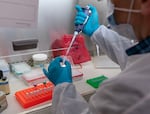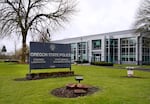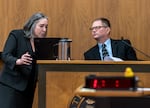Note: This story contains a description of suicide. If you or someone you know may be considering suicide, contact the Suicide and Crisis Lifeline by dialing 988, or the Crisis Text Line by texting HOME to 741741.

Robert Atrops attends a hearing at the Washington County Courthouse in Hillsboro, Ore., March 6, 2025. Atrops was arrested in 2023 for the 1988 cold case killing of his wife, Deborah Atrops, who was strangled to death and found in the trunk of her car.
Kristyna Wentz-Graff / OPB
Beaverton police found the abandoned car parked at the woods’ edge on a dead-end road. The chill of the December 1988 morning left the windows frosted, the driver’s side rolled down. The keys sat inside.
When officers looked in the trunk, they found Deborah Atrops, strangled to death. Her blue coat and black heels were covered with mud.
From early on, detectives honed in on her husband, Robert Elmer Atrops, as the primary suspect. The two had married the year before, but had been estranged for months before Deborah’s disappearance and some close to her worried for her safety.
Police worked the case for months, but ultimately didn’t have enough evidence to bring charges. By the fall of 1990, after more than a year of investigation, the case stalled.
It stayed that way for decades. Then, nearly 35 years after Deborah Atrops went missing, Washington County prosecutors declared they finally had solved her murder. A grand jury charged Robert, now 70, with the killing.

Robert Atrops was charged in 2023 for the 1988 murder of Deborah Atrops.
Courtesy of Washington County Sheriff's Office
The case — scheduled to begin trial Tuesday in Hillsboro — is the first to go before a jury since the county formed a cold case unit in 2020. It serves as an example of how advances in DNA technology allow law enforcement to reconsider and even solve cases decades after the fact.
“There’s no way they could have contemplated the advances that were made in DNA technology between then and now,” Washington County District Attorney Kevin Barton told OPB shortly after his office charged Atrops in 2023. “Being able to use today’s technology and apply it towards evidence that was seized over 30 years ago is a huge advantage.”
While DNA may have helped unlock the case, it could also unravel it.
Robert Atrops’ defense team argues the Oregon lab got its DNA analysis wrong or presented misleading results due to a complex technology that relies heavily on expert interpretation far beyond an average juror’s understanding. They question the significance of a husband’s DNA potentially being on his wife’s coat, and say law enforcement failed to truly consider and investigate another possible suspect.
Washington County prosecutors meanwhile argue the lab did nothing unusual. They’ve pointed to the crime lab staff’s individual and collective experience conducting thousands of DNA tests each year as reasons the analysis supports their theory that Robert Atrops killed his wife.
The Washington County District Attorney’s Office, the Oregon State Police Crime Lab, Robert Atrops and his defense attorneys all declined interview requests, citing the upcoming trial.
The outcome of the case, regardless of who wins, will likely have a significant impact on the credibility of the state crime lab’s DNA protocols, the efficacy of the county’s cold case unit and the search for justice for Deborah Atrops.
A grant. A test. A murder charge

Kevin Winfield testifies during a pre-trial hearing at the Washington County Courthouse in Hillsboro, Ore., March 6, 2024. Winfield was hired by the Washington County District Attorney’s Office to head up a newly formed cold case unit in 2020, taking on the decades old murder of Deborah Atrops.
Kristyna Wentz-Graff / OPB
The Washington County District Attorney’s Office was optimistic in 2020. It secured nearly half a million dollars from the federal government to address at least 14 “violent crime cold cases that involve identified DNA associated with a possible suspect” along with other sexual assault cases.
The county soon hired Kevin Winfield, as a part-time, special deputy to lead a newly-formed cold case unit. Winfield had recently retired after a lengthy police career in Cannon Beach and the Tualatin Police Department, where he investigated homicides and other major crimes. They also made a former DNA supervisor at the Oregon State Police Crime Lab their forensic consultant.
Just months into his new job, Winfield picked up the case file for Deborah Atrops’ murder. Though police had not charged anyone at the time with the killing, they kept DNA samples from Atrops’ autopsy and clothing that could still be tested.
To piece together the issues central to the Atrops case, including the role DNA plays, OPB relied on court records, transcripts from pretrial hearings, numerous published studies and papers by academics who research DNA analysis, and spoke to several forensic experts, none of whom are associated with the case.

Washington County Senior Deputy District Attorney Allison Brown, during a hearing at the Washington County Courthouse in Hillsboro, Ore., March 6, 2024.
Kristyna Wentz-Graff / OPB
On June 16, 2021, Winfield and Washington County Senior Deputy District Attorney Allison Brown met with staff from the state police crime lab, including DNA analyst Heather Feaman. At the meeting, the group discussed how they would test the decades-old Atrops evidence.
After the meeting, a lab scientist emailed notes, detailing the items they planned to run through DNA analysis — a stroller recovered from the trunk of Deborah Atrops’ car; keys to the vehicle; and a red dress, watch and blue coat she wore the night she died.
The Washington County Sheriff’s Office was tasked with gathering samples from people whose DNA might be found on that evidence. That list included Robert Atrops, the daughter he adopted with Deborah and any romantic partners Deborah Atrops had when she died.
“This all looks accurate to me,” Brown replied, thanking the crime lab staff. “I really enjoyed the discussion and am excited about the [possibility] of solving this case!”
The complexities of DNA analysis
Jurors hearing the Atrops case will be asked to understand and interpret how Oregon law enforcement tried to connect him to the crime scene with DNA.
DNA, short for deoxyribonucleic acid, is a molecule that contains genetic information. Half from our mother and the other half from our father, DNA resembles a twisted ladder called a double helix and carries chemicals that make up the building blocks of life. Since its first use in a criminal case in 1986, DNA has been considered the “gold standard” of evidence, lionized in popular media through TV shows such as “CSI” and “Bones.” It has helped bring serial killers to justice and saved innocent people from imprisonment.

DNA evidence is processed at Washington State Patrol’s Crime and Forensic Laboratory in Vancouver, Wash., March 14, 2025. DNA lab technology has advanced to the point where analysts can get a result using just a few skin cells.
Kristyna Wentz-Graff / OPB
Early on, crime labs needed substantial quantities of DNA samples for testing, such as blood or semen. Lab technology has advanced today to the point where analysts can get a result using just a few skin cells.
Increasingly sensitive DNA tests can not only pick up the DNA of a victim or suspect, but anyone else who has come into contact with that item. Cells can also be transferred on shared items such as a pen, or even by laundering clothes in the same washing machine. While more microscopic DNA samples can be tested thanks to advances in technology, it can be harder to draw accurate conclusions from those results.
Staff at the Oregon State Police Crime Lab managed to collect these types of small DNA samples from the cuff, collar and shoulder area of Deborah Atrops’ coat.
Feaman, the state analyst, then followed standard steps to process the DNA sample, running it through a machine to produce an image that looks like a graph, with brightly-colored peaks of various sizes scattered across it.

Court documents show this electropherogram, a graph representation of a DNA sample taken from part of the blue coat Deborah Atrops wore the night she was killed. Here, the graphic has been recreated by defense experts using OSP lab data. Analysts use graphs like these to help interpret DNA evidence found at crime scenes.
Obtained via court records
Genetically, humans are practically identical — about 99.6%, according to the National Human Genome Research Institute. The graph helps scientists analyze those tiny differences in DNA evidence taken from crime scenes.
Feaman interpreted the graph to mean four people contributed to the DNA mixture.
To better understand the results, she turned to a software common in forensic labs across the country: STRmix, pronounced like “star mix.”
“A DNA mixture is pretty complicated — there’s a lot of information being thrown at a DNA analyst when they see a DNA mixture,” Marla Kaplan, the DNA technical leader at the Oregon State Police Crime Lab, explained during a pretrial hearing in May. “What the STRmix software does is it takes that complicated DNA mixture and breaks it down.”
STRmix compares probabilities. It calculates the likelihood of observing the evidence if the suspect’s DNA was the donor, compared to a random person’s DNA – commonly known as a “likelihood ratio.” The larger the number, the more support there is for the prosecution’s hypothesis that the suspect is the contributor to the DNA evidence.
There’s no limit on how big the number can be — with some results stretching into numbers so large, lab analysts sometimes use charts to remind themselves how to read the data.
When comparing Robert Atrops’ DNA to the coat sample, the Oregon lab got a very weak likelihood ratio — 132. It’s one of the weakest results analysts could’ve gotten, barely above an inconclusive result, according to the lab’s internal scale.
Test and test again

Oregon State Police’s Forensic Laboratory and Medical Examiner Division offices in Clackamas, Ore., March 20, 2025.
Kristyna Wentz-Graff / OPB
Another problem, Atrops’ defense would later argue, is how the lab got those results.
Feaman would end up running the DNA analysis three times before completing her report. The first time she ran it, she didn’t get a result that looked correct. So she consulted her boss, who recommended she change the software parameters and inputs. Feaman did that, twice.
It was only after those adjustments to the software, and the third test, that Robert Atrops finally appeared with the 132 likelihood ratio.
Only that final result was included in the report which the county’s attorneys would then push as evidence of Atrops’ guilt.
According to Atrops’ defense team, the steps Feaman took that day should render the DNA evidence inadmissible in court.
First, attorneys argue that Feaman may have incorrectly identified the number of people who contributed DNA to the mixture, assuming it was four when it was possibly five. A 2018 study conducted by the inventors of STRmix, which the Oregon lab participated in, found that “as mixture complexity increases, the ability of an analyst to designate the known number of contributor is reduced.”
“Almost two-thirds of the time, the number of contributors was underestimated,” said Dan Krane, CEO of Forensic Bioinformatics, a consulting company that reviews forensic DNA testing.
Krane, who is also a professor of biological sciences at Wright State University in Dayton, Ohio, spoke as an expert witness for the defense during pretrial hearings. He noted the study shows nearly 60% of the time, “five-person mixtures were characterized as four-person mixtures.”
While the difference between a four- or five-person mixture may seem small, the impact would be significant: The Oregon lab does not test DNA mixtures that contain five or more people.
“The software might not function if we try to interpret that,” the Oregon lab’s Kaplan said during a pretrial hearing. “It will not work.”
Prosecutors have said that the STRmix study relies on analysts only looking at one narrow aspect of the DNA testing, and that analysts at the Oregon crime lab use all the tools at their disposal to estimate contributors.
Defense attorneys for Atrops have also focused on the repeated tests needed to get a result potentially linking their client to the murder. During a pretrial hearing on Oct. 3, defense attorney Janis Puracal questioned Feaman.
“My recollection of what you testified to is that there are times where, if you look at the data and it doesn’t make sense, you can change the STRmix parameters,” Puracal said. “Which part of the protocol are you referring to?”
“I don’t think that it’s specifically laid out in the protocol exactly when to do that,” Feaman replied. “The protocol talks about assessing all of your results and making sure that they are intuitive, they make sense.”
“There’s no step-by-step for when you can change those parameters on STRmix?” Puracal pressed.
“No,” Feaman said.
Beyond the tests themselves, Atrops’ lawyers have accused the lab of violating the law by not sharing the initial tests that excluded Robert Atrops.

Defense attorney Janis Puracal attends a pre-trial hearing at the Washington County Courthouse in Hillsboro, Ore., March 6, 2024. Puracal is one of three defense attorneys working on Robert Atrops’ case, focusing specifically on DNA evidence.
Kristyna Wentz-Graff / OPB
“You did not report those exclusionary likelihood ratios for Mr. Atrops in the first and second round,” Puracal said during the same hearing last October.
“They were not in the report,” Feaman responded.
Prosecutors have pushed against the defense’s narrative of events, and defended lab staff and their analysis. Washington County Deputy District Attorney Chris Lewman argued that while DNA analysis does require complex equipment and software for testing, it’s the lab analyst’s job to apply their expertise to any results.
“We don’t know the ground truth for any forensic sample,” Feaman told Lewman during the pretrial hearing. “So we can never say that ‘this is four people.’ But that is an opinion that I am trained to assess in every DNA profile I look at.”
Prosecutors also argue that information can change over the course of an investigation, so it’s not unreasonable for a lab analyst to adjust software parameters, like Feaman did for Atrops.
“If you run into some issue where you need to investigate further, like you did, that’s what you’re supposed to do, right?” Lewman asked.
“Yes. STRmix is not a black box,” Feaman replied. “You have to evaluate the output and make sure it makes sense with what you know as a qualified DNA analyst.”
Lewman defended the state lab’s process in October because the defense asked to have the DNA excluded from the trial.
“Of course DNA is relevant in a murder case,” Lewman said. “[Juries] always want to see DNA in a person-crime case.”
It’s not yet clear the significance that prosecutors will attach to the possibility a husband’s DNA was left on his wife’s coat, particularly since no one knows for certain when or how it got there — whether it was left while committing a crime, or something more innocuous, such as picking up her coat.
Ultimately, Washington County Circuit Court Judge Oscar Garcia ruled that he would allow the evidence in, saying jurors would be capable of assessing the complex science that goes into DNA results.
Experts warn that can be tricky.
“This kind of scientific evidence is difficult to understand,” said William Thompson, professor emeritus at the University of California, Irvine, who specializes in forensic science. “People are bad with numbers in general and likelihood ratios are necessary in order to characterize the strength of DNA evidence.”
Another suspect?
Deborah and Robert Atrops got married in 1987. The couple lived together in Sherwood and adopted baby Rhianna in March 1988. But their relationship appeared to be falling apart. In late spring of that year, Deborah allegedly came to work crying and told a coworker that Robert had been physically violent toward her, according to prosecutors.
By June, the two had separated. Deborah moved into an apartment in Salem, while Robert stayed in the house.
She was the primary caretaker of their infant daughter. At the time of her death, Deborah was dating a coworker, John Pearson. The two began seeing one another after a company picnic in August 1988. Pearson was also separated from his wife.
As time passed, his importance to the case would only grow: as a vital witness for the prosecution and a possible alternative suspect to the defense.
After Deborah disappeared, Pearson worked with police to track down details about her. In a 1988 interview, he reportedly talked about what was in her car when she died. Decades later, defense attorneys seized upon it.
“Pearson gave very specific and accurate details about some of the contents, down to the brand of fast food trash in Ms. Atrops’ car and trunk on the day she was murdered,” defense attorneys noted in court documents, citing a police report from the time of the murder.
“Mr. Pearson also accurately predicted that in order for Deborah Atrops’ body to fit in the trunk, some of the items would have to be moved from the trunk. This is consistent with what police documented when her car and body were located.”

A copy of the article in The Oregonian showing Washington County sheriff’s deputies and investigators at the scene where the body of Deborah Atrops was found, Dec. 1, 1988.
Courtesy of The Oregonian
Police never seriously considered Pearson a suspect. At the time of Deborah Atrops’ death, he told investigators that he was at home with his estranged wife. Prosecutors said his wife corroborated that alibi in 1988. According to the defense, there are no notes of this conversation with Pearson’s wife, and it was not recorded.
Other things Pearson said could become a crucial part of the prosecution’s case. Among them, Deborah Atrops allegedly told Pearson and another coworker before her death that if Robert Atrops ever found out about her relationship with Pearson, he’d kill her.
“[Pearson] was entirely cooperative with the investigation in 1988 and with the investigation now,” prosecutor Allison Brown argued during an October hearing.
He initially agreed to testify at Robert Atrops’ trial, but never made good on his commitment to participate.
After the Atrops investigation reopened, Winfield submitted several items to the Oregon State Police Crime Lab for DNA analysis. The lab found semen cells when analysts tested vaginal swabs taken during Deborah’s autopsy.
On June 29, 2021, Winfield called Pearson at his home in Prineville to let him know Washington County reopened the murder investigation. According to Winfield’s testimony during a pretrial hearing last month, he asked Pearson to sit for an interview and give a DNA sample. Pearson agreed. But before the two could meet, the deputy told Pearson he needed to resolve an unrelated warrant from his 2002 divorce.
If he didn’t clear it, Winfield — just like any law enforcement officer — would be forced to arrest Pearson.
“He was unhappy about that,” Winfield said during a hearing in early March. “He thought I was trying to set him up or trick him.”
According to the deputy, Pearson told his brother-in-law that “he thought that I was trying to pin the murder on him because I brought up DNA,” due to the fact that his DNA would be all over Deborah because of their relationship.
Pearson hired an attorney and eventually cooperated, submitting his DNA for testing.
In late November 2022 — just before the anniversary of Deborah Atrops’ death — Pearson was stopped by police in the parking lot of the Club Pioneer restaurant in Prineville. He was clearly inebriated, and sitting behind the wheel of his vehicle. When police told him to get out of the car, Pearson drove out of the lot. He eventually stopped in front of his house and police charged him with an attempt to elude, drunk driving and a number of other offenses.
A month later, the state crime lab found that Pearson could not be excluded as a contributor to the DNA on the vaginal swab taken from Deborah Atrops.
By early 2023, Atrops sat in jail charged with Deborah’s murder and Pearson was on the move. He embarked on a monthslong road-trip where he zig-zagged across the Pacific Northwest, Nevada and California. He sold his truck, bought an RV, and left for what would be his final stop, Arizona. All while his Crook County case was pending.
On March 15, 2024, Pearson failed to appear at court and a judge issued a warrant for his arrest.
With Atrops’ trial just months away, Winfield checked up on Pearson. Knowing the additional warrant would create challenges in the Atrops case, Winfield called Pearson to figure out what was going on. He left a voicemail.

Defense attorney Stephanie Pollan questions Kevin Winfield about his communications with John Pearson, during a pre-trial hearing at the Washington County Courthouse in Hillsboro, Ore., March 6, 2024.
Kristyna Wentz-Graff / OPB
Even though Pearson didn’t answer that July phone call, AT&T records — detailed in defense court documents — indicate that he did listen to the voicemail two minutes after Winfield called and then immediately rang his attorney.
That would become a recurring pattern, according to the defense; Winfield calling, Pearson avoiding. Between July and October 2024, Winfield left Pearson five voice messages. All went unanswered, but Pearson listened to every message, minutes after it was left. He then immediately called and spoke to his attorney or his son, the records allegedly show.
Washington County prosecutors claim that Pearson’s reluctance to speak stemmed from the Crook County case. He feared, they argue, that his drivers license would be taken away or he’d be taken to jail. On top of that, they said he was ill with compounding health problems, including chronic obstructive pulmonary disease (COPD), and had a history of depression.
Brown, one of the Washington County prosecutors, mailed a subpoena to Pearson’s house in Prineville on Aug. 6, 2024, that required he testify at Atrops’ trial. Pearson wasn’t there, and didn’t respond to that or several other attempts to contact him.
Prosecutors resorted to their last option: issuing a warrant compelling his appearance in court. In October 2024, just before trial was scheduled to begin, the Mohave County Sheriff’s Office tracked Pearson down at an RV park in Arizona. When they attempted to serve the warrant and take him into custody, Pearson peeked outside.
“I can see you too,” he reportedly said after officers announced themselves. Pearson then pointed a gun to his head and fired one shot.
Pearson’s suicide delayed the Atrops case for months. Defense attorneys have argued that his death may be directly connected to the murder case: that Pearson did not want to testify and chose suicide to avoid further scrutiny. The prosecution attributes the suicide to Pearson’s overall health and his fear that if he returned to Oregon, he’d lose his drivers license and be unable to legally drive — one of the few things he could still do despite his health.
Pearson’s death is the latest in a series of complications obstructing the effort to find out who killed Deborah Atrops.
Cold cases are rife with challenges, even in the best of circumstances. Physical evidence has often degraded. Witnesses can misremember details, making their testimony unreliable. Fresh murders arise, demanding law enforcement’s attention.
Without Pearson, prosecutors have lost a key witness who was close to Deborah in the days leading up to her death. That leaves more esoteric evidence, like the STRmix DNA analysis. Both sides plan to bring in experts to sway jurors to their view of the complicated science.
And the stakes couldn’t be higher.
For Washington County, the Atrops case is the first time investigators and prosecutors can prove federal money they received was well spent, and that crime victims — like Deborah Atrops — can find justice even if it takes many years.
For the 70-year-old Robert Atrops, the trial means no less than his life. If convicted, he could spend the rest of his living years in prison.
